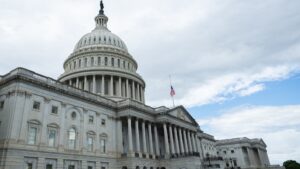Understanding the Impact of Rising U.S. Debt on Personal Finances
In a significant turn of events, House Republicans recently passed a sweeping tax cut package expected to increase the U.S. national debt by trillions. With estimates suggesting a staggering addition of between $3.1 trillion to $3.8 trillion over the next decade, the implications of this legislation extend far beyond the halls of Congress. At Extreme Investor Network, we believe that understanding these developments is crucial for safeguarding your financial future.
What the Tax Cuts Mean for National Debt
The potential addition of trillions to the national debt raises concerns among economists and voters alike. Representative Thomas Massie of Kentucky labeled the proposed legislation a "debt bomb," warning of its ability to dramatically increase deficits shortly. Such fiscal irresponsibility may lead to long-term consequences that we cannot afford to ignore.
Why Should You Care?
The increase in national debt may seem abstract, but its impacts are very much tangible for the average consumer. When the government borrows excessively, consumers often bear the brunt through higher interest rates on loans, mortgages, and credit. As mortgage rates inch up, the dream of homeownership can drift further out of reach — particularly for first-time buyers.
The Consumer Loan Crisis: Higher Costs Ahead
Mark Zandi, Chief Economist at Moody’s, predicts that consumers will likely experience significant increases in financing costs for everyday purchases. As the cost of consumer loans skyrockets, individuals and families may struggle to secure even the most basic necessities — homes, cars, and education.
The Ripple Effect: How Debt Affects Treasury Yields
Why should we care about Treasury yields? The answer lies in their direct correlation to loan rates. As investors begin to perceive the U.S. government as a higher-risk borrower due to rising debt, they will demand increased yields from Treasury bonds to compensate for that risk. This phenomenon will lead to higher borrowing costs for consumers.
In practical terms, a rising debt-to-GDP ratio—currently around 101%—could push 10-year Treasury yields significantly higher, potentially exceeding 5%. For borrowers, that could translate to a fixed 30-year mortgage skyrocketing from roughly 7% to approximately 7.6%.
Bond Markets: The Hidden Casualty
It’s vital to consider that rising interest rates will not only affect consumers but also investors holding existing bonds. As Treasury yields increase, the prices of current bonds will fall, leading to a decline in investment portfolios. If you’re invested in long-term Treasury bonds, you might need a strategy pivot to mitigate losses.
A Direct Line to Our Finances
Economists emphasize that the connection between national debt and household finances is undeniable. Rising interest rates can prolong the financial recovery for many Americans, especially those grappling with student loan debts, auto loans, and mortgages.
Investing in more secure financial instruments could be a smart move as high-interest debt becomes more pronounced. It’s also wise to explore options such as refinancing current loans while rates are still relatively low.
Vigilance is Key
While economic forecasts can act as a guide, they can also change rapidly. Raising national debt levels will impact financial markets and consumer affordability. At Extreme Investor Network, we urge you to stay informed and consider proactive strategies for your financial future.
As the implications of the tax cuts ripple through the economy, empowering oneself with knowledge and planning can provide a significant buffer against these turbulent financial times.
For more insights tailored to your needs, continue to connect with us at Extreme Investor Network. Together, let’s navigate the evolving landscape of personal finance and secure a prosperous future.

